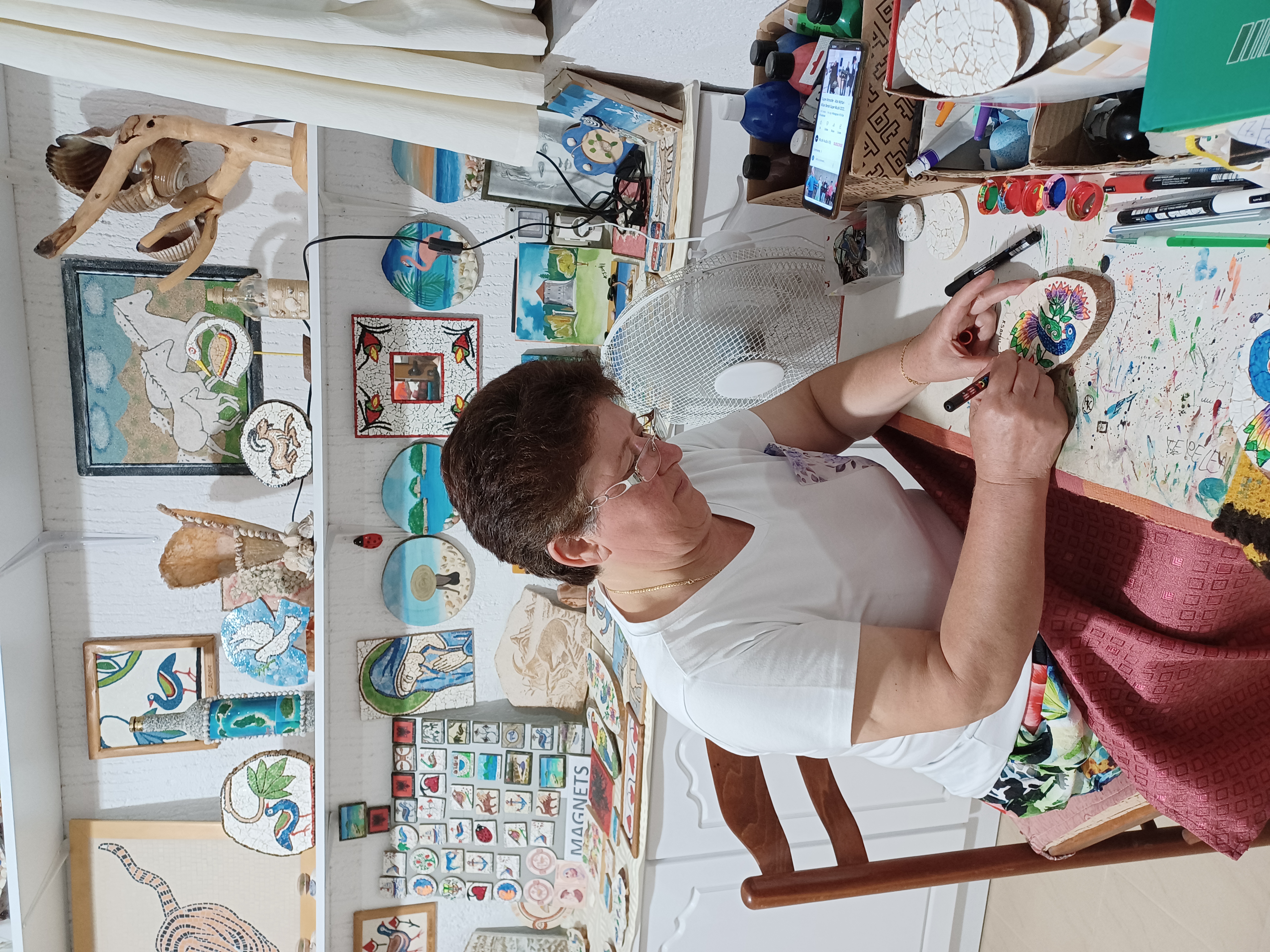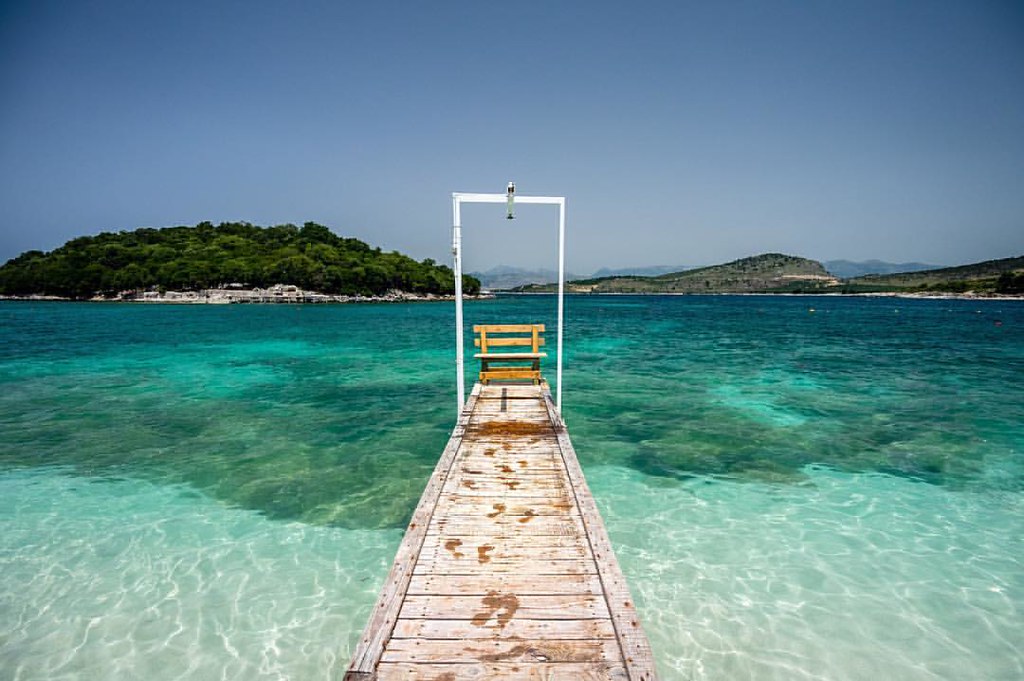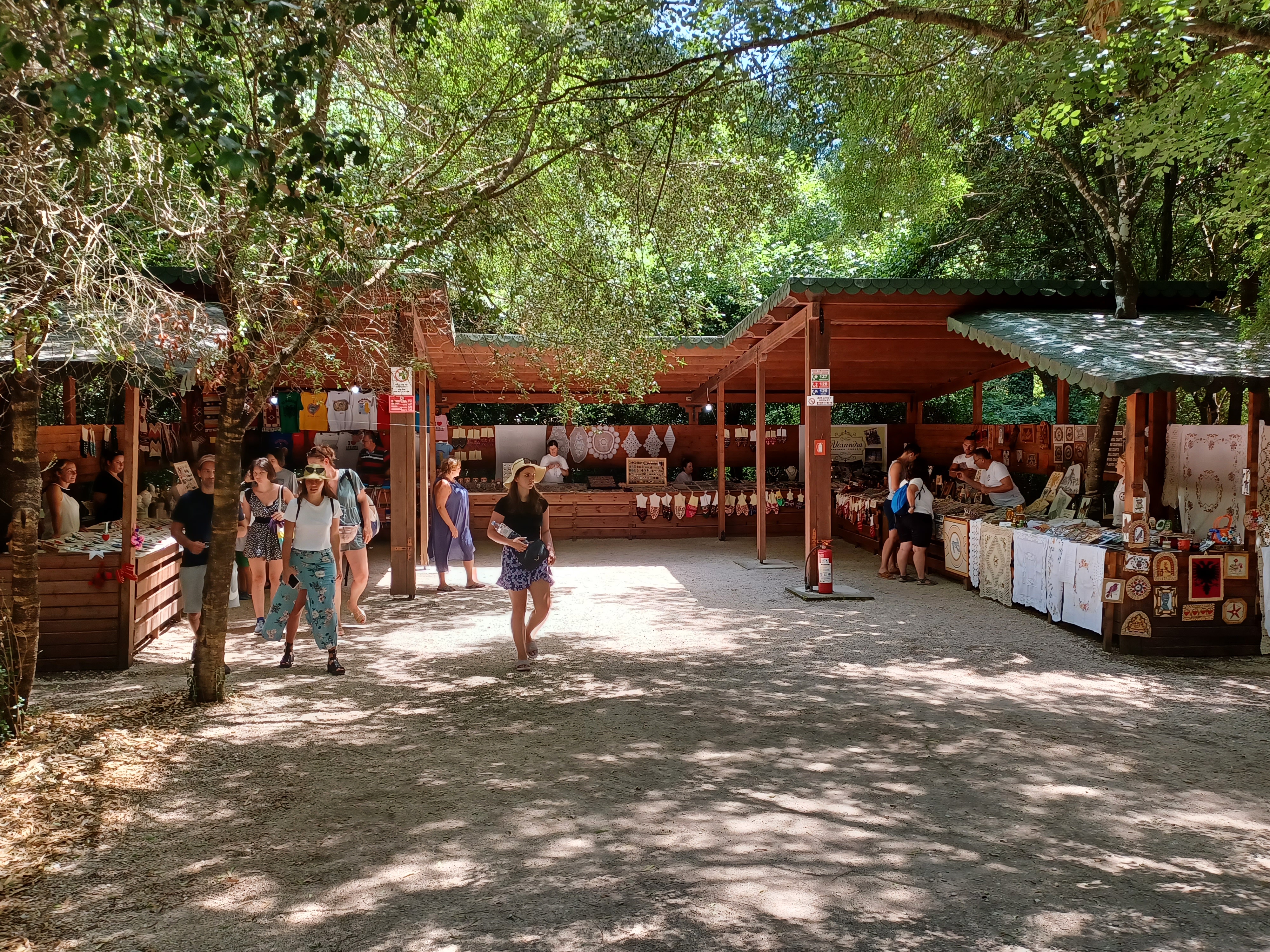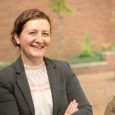Ksamil, Albania 2017
Down a hidden alley, near the central roundabout of Ksamil, an arched door embroidered by a magenta bougainvillea vine catches the eye. Next to the bougainvillea, a little workshop selling “Punime Artizanale” (“Artisanal Crafts”) is adorned with a mosaic of the bird of paradise, an iconic image from the nearby UNESCO protected archaeological park of Butrint.
When I first walked into the property, I was struck by the sense of order and calm. The luscious yard was a peaceful oasis unlike anything else I had seen in Ksamil. The garden surrounded a two-story house, the home of Agur and Suzana Kapo, residents of Ksamil since the early 2000s.
The Kapos’ main business is renting out several rooms to tourists during the summer. Filling the off-season, they make crafts year-round sourced from local materials and featuring images from the ruins of Butrint.
It was the bougainvillea that first drew me to the house, but it was the garden, the couple, and their love of their workshop that kept me coming back every few years.
The sense of order at the Kapos’ property stands in sharp contrast to the disorder and never ending construction in the rest of Ksamil, which is defined by unfinished roads, incomplete and demolished buildings sitting next to shiny new hotels, a lack of trees and shade, and overpriced restaurants and clubs by the waterfront. I have often wondered why the town continues to look like a work in progress thirty years after the migration and tourism began. And how do people like the Kapos persist and continue to thrive in the midst of and despite the chaos?
Ksamil has rapidly transformed from an uninhabited shoreside to a “model socialist village” and military zone to a tourist destination.
The life story of the Kapos’ is intertwined with the contradictory urban developments in Ksamil. It is a story that speaks to the waves of internal and external migration and the transformations of Ksamil from an uninhabited shoreside to a “model socialist village” and military zone to a tourist destination. This is also a story of migrant labor, entrepreneurial ingenuity and creativity that have developed as an antidote to the uncertain and precarious living conditions in the Albanian southern Riviera.
An oasis amidst chaos
I was researching the construction boom in the southern Riviera when I first encountered the Kapos’ garden in summer 2015. Many referred to the town as Kabul, the Afghan capital that was, at the time, making the news for car bombings and military strikes. Houses were built in whatever plot of land one could grab, there was no urban plan, some houses were half finished due to property disputes or a lack of money. A raid on “informal” construction had destroyed around 200 such houses, with much of the rubble left in place. Roads were mostly unpaved, the few sidewalks mostly covered in trash.
I have visited the Kapos regularly since 2015. Every time I visit I notice changes. In 2015, there wasn’t too much beyond the Kapos’ personal residence. In 2017, the veranda on the second floor was turned into an additional apartment for tourists. In 2022, the Kapos had installed new appliances in the tourists’ rooms.
Ksamil has changed too. A new boardwalk gave the town space for the evening ritual of xhiro, a staple of Mediterranean urbanity. Inexpensive restaurants at the center of town cater to the low-budget tourist families from Kosovo, Macedonia and Poland while upscale seafood restaurants by the waterfront lure in the Italian and French seniors.
During my last visit, I sat one evening in the workshop to chat with Suzana while she painted eggshells for magnets she was working on. I asked her about how they built the house.
“We settled here in the early 2000s. We got a plot of land. Without papers, that’s how it was at the time. And then we began to build the house, little by little,” she said. “It took us one year to build the first floor. We added the other floor and the decorations later.”

Suzana Kapo works in the family’s crafts workshop. Photo: Smoki Musaraj.
The Kapos’ process of constructing “little by little,” adding one floor, one apartment, one decoration at a time over several years reflects a widespread pattern of informal construction in Albania. Internal migrants often build their own homes without taking a bank loan and with no input by architects or engineers. It is an erratic construction process, shaped by the irregular and unpredictable flows of remittances and the short-term jobs available in the area.
Uncertainty and unpredictability in construction is also subject to the fickle nature of the state and the rule of law. Ksamil residents express a deep distrust of the state. “Shteti është, shteti nuk është” says Agur. The state is, the state isn’t. Legalization and property rights continue to be an unfinished business in the country 30 years after the reinstatement of the right to private property.
Most informal buildings in Ksamil have been legalized, that is, they’ve received legitimate deeds. These waves of legalization often take place just before elections, serving as a vote-buying mechanism. However, the legalization process has been uneven and incomplete. Some houses still are missing deeds, and, as Agur explained, “when a new party comes to power, it denies the rights of those who received these legalizations earlier.” Property conflicts arising from these discrepancies between law and practice have often pitted neighbor against neighbor, kin against kin.
Unstable income and property disputes contribute to the unsettled landscape of Ksamil, which Francesco Vietti describes as a post-post-socialist landscape, with the remnants of the socialist town still visible but overtaken by multiple waves of post-90s constructions and demolitions.
From military zone to tourist destination
Unlike neighboring villages that trace their history over multiple generations of human settlement, Ksamil is the product of 20th century social experimentation, agricultural innovation, government surveillance and mass migration.
The town is perched on the Ionian Sea across a narrow channel from Corfu, only a few kilometers from the Albanian-Greek land border. Up until the middle of the 20th century, Ksamil was an uninhabited cluster of small bays, hills and islands. In the 1960s, following a visit by the former dictator Enver Hoxha and the Soviet leader Nikita Khrushchev, a plan was drawn to set up a “model socialist village.”
Located so close to the border with Greece, Ksamil was a military zone under the communist regime.
The village was settled by members of a newly established cooperative — many of whom still live in Ksamil — coming from the mountainous villages of Tepelena and other remote areas. Members of the cooperative as well as forced laborers built and maintained terraces of olive groves and citrus trees. Traces of the terraces remain at the edge of town to this day, though most were overtaken by new construction.
Located so close to the border with Greece — a country with which Albania was officially at war during much of the 20th century — Ksamil was a military zone under the communist regime. Movement was restricted and everyone was under surveillance.
Early residents describe the searchlights that would wash over the village repeatedly at night, the border patrols, the constant tension. The military zone status made Ksamil inaccessible to the general population of Albania. There was a state-owned tourist hotel but only high-level officials had access.
In the 1990s, as the communist system collapsed, Ksamil transformed into a totally new town. The Kapos were some of the first new arrivals in the 2000s and they’ve watched the village grow from 2,000 to 9,000 people.
The Kapos identify as Çams, an ethnic group of Albanian origin that was ethnically cleansed from northern Greece. Many of the surrounding villages were historically inhabited by the Çams. After the removal of the strict residence rules in the 1990s, many of these Çam residents moved to Ksamil. Other newcomers came from all over the country.
Internal migrants old and recent brought multiple religious identities and houses of worship to Ksamil. This ethnic, regional and religious diversity is a unique feature that distinguishes the town from the other tourist villages of the southern Riviera, like Dhërmi and Vuno/Jalë, where Orthodox churches dominate. The Kapos, who are Muslim and have resided in the region for generations, feel that Ksamil belongs more to people like them than to more recent migrants from farther afield.

Ksamil has become an international tourist destination celebrated for it’s stunning waters and beaches. Photo: Creative Commons.
One of the reasons why Ksamil developed so fast in the past two decades is its lack of historic residents. In contrast to places where pre-communist landowners, or their descendants, made claims on lands that had been seized by the state, Ksamil’s previously unsettled status meant it was wide open to people seizing land and building housing.
A tourism industry began to flourish in the region as the restrictions on access to the zone were lifted. Alongside the budget-friendly beach tourism, in 1992 Butrint National Park was declared a UNESCO world heritage site and began to attract international tourists. Butrint has also served as a source of inspiration and entrepreneurial ingenuity for people like the Kapos.
The man of stone
“As my name, Gur [stone], indicates,” he joked with me in one of our first meetings, “I have worked with stone since I was 16.”
Born and raised in the village of Markat, not far from Ksamil, he migrated to Greece in the 1990s, as most people in the region did at the time. There he worked in construction for 10 years, and gained expertise in masonry and facade-building techniques.
“The Greeks don’t like Albanians,” noted Suzana, “but they valued Agur’s work and they paid him fairly.” Having gained much experience and a little money, Agur returned to Albania, mainly because Suzana wanted to settle in Ksamil, where she was working as a math and physics teacher.
In the early 2000s, Agur worked in construction in Ksamil and helped build around 30 houses. “I was the engineer, designer and developer,” he said. “I took the Greek construction plans and applied them here. There were no rules or plans. We just copied one another.”
'All the beautiful houses in town were built by immigrant investments from those migrating to Italy or Greece,' said Suzana.
These were years of unbridled construction across Albania, and the residents of Ksamil rushed to put a roof over their heads, to claim a land plot, to finish a house so it would get legalized. After some time, demand for artistic decorations emerged. Agur started to receive contracts to build fountains, sculptures, even mosaics similar to those that adorn his workshop and the house.
Like most self-built houses in Ksamil, the Kapos’ embodied immigrant labor. “All the beautiful houses in town were built by immigrant investments from those migrating to Italy or Greece,” said Suzana. “I threw all my immigrant savings into the house,” said Agur.
The remittance economy has been a significant source of income stability for Albanians who lacked other opportunities. As academics Julie Vullnetari and Nataša Gregorič Bon note, remittances sent by migrants consist of much more than money. They often include material goods, expertise, taste and style, even love. Most of Agur’s and Suzana’s siblings have migrated abroad, to Greece, Italy and the United States. Transnational family networks like these provide a safety-net in moments of uncertainty and crises.
A passion for Butrint and craft
Agur was not trained as an artisan, it all started as a hobby. Over the years, he passed down techniques he’d learned to other family members. The guiding principles of Agur’s craft are that his products have to be handmade and use local materials. Agur and family now produce a wide range of objects using sand from the nearby lagoon, stone from the region and seashells from the Ionian Sea.
In addition to the workshop on his property, Agur sells his handicrafts at Butrint’s artisans’ market alongside other vendors. In 2017, the Butrint Foundation handed management of the park over to the state, which increased fees for vendors. That summer, Agur was extremely agitated, worrying that local artisans would be cut out of the park.
By 2022, Agur was in a much happier mood. Thanks to his leadership, the artisans had created an artisans’ association which performs quality control and provides a voice for the vendors.
Despite the sense of relative stability, Agur is worried future plans for developing Butrint into a global cultural heritage site might sideline local artisans. The Albanian-American Development Foundation, which has managed Butrint since 2020, has expressed a commitment to sustainable tourism and development of local economies but other similar development projects in Albania notoriously exclude local businesses like the artisans, who are, I’ve found, some of the best cultural tour-guides of the archaeological site.

The Kapos sell their wares at the artisans’ market at Butrint National Park. Photo: Smoki Musaraj.
In their craft, they incorporate the imagery and symbolism of the many cultures represented in the ruins. In the artisanal market, images from the baptistry are predominant. Vendors explained to me the meaning of various images reproduced from the baptistry mosaic — the bird of paradise, the fountain of baptism. Despite my many visits, I’ve never seen the mosaic itself because it spends most of its time covered in sand to protect it from the elements. But I feel like I have experienced it through my interactions with the artisans.
When I last visited Ksamil in 2022, Suzana and their son, Redon, had joined the workshop. Suzana was working with eggshell mosaics, Redon was taken by the stone mosaics. Agur spent most of his time on the stone carvings. Commitment to the workshop is driven not just by a desire to make more profit but also by a longing for creativity in a world that is driven by a fever of money-making and ridden with uncertainty and precarity.
The workshop also pulls the family through the off-season. “Winter here is a cemetery,” Agur said the first time I met him. “I go to a cafe and there are only three of us there.” By 2022, things hadn’t changed much, “Winter is a bit difficult,” noted Suzana. “There is nothing to do. People leave, restaurants close. So I spend time working on these crafts every day.”
As I chatted to Agur and Suzana over the years, and more recently with Redon, I have come to see how artisanal work is a passion that helps the family create continuity and stability in the midst of much change and uncertainty.
The paradoxes of Ksamil — a tourist destination whose natural beauty has recently been compared to the Maldives, contrasted by the uncertainty and precarity of the lives of the town’s residents — continue to shape the town’s economic and social life. It is against this landscape of paradoxes that the Kapos have managed to carve their oasis of peace, creativity and modest prosperity.
Feature image: Creative Commons.




